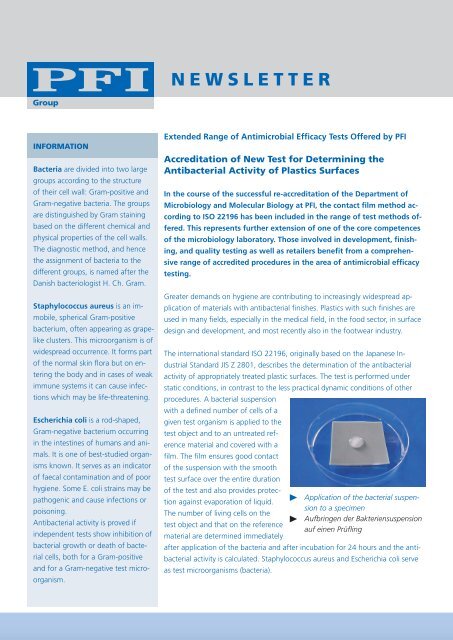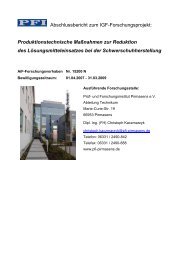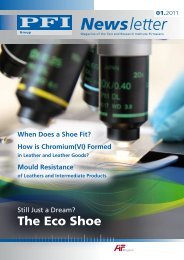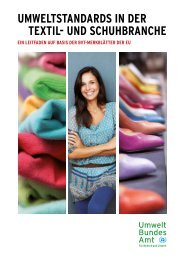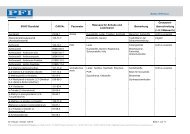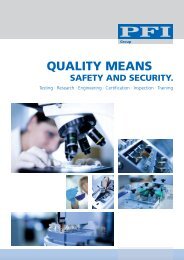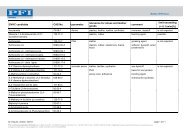newsletter - Point of Shoes kommt gut an
newsletter - Point of Shoes kommt gut an
newsletter - Point of Shoes kommt gut an
Erfolgreiche ePaper selbst erstellen
Machen Sie aus Ihren PDF Publikationen ein blätterbares Flipbook mit unserer einzigartigen Google optimierten e-Paper Software.
INFORMATION<br />
Bacteria are divided into two large<br />
groups according to the structure<br />
<strong>of</strong> their cell wall: Gram-positive <strong>an</strong>d<br />
Gram-negative bacteria. The groups<br />
are distinguished by Gram staining<br />
based on the different chemical <strong>an</strong>d<br />
physical properties <strong>of</strong> the cell walls.<br />
The diagnostic method, <strong>an</strong>d hence<br />
the assignment <strong>of</strong> bacteria to the<br />
different groups, is named after the<br />
D<strong>an</strong>ish bacteriologist H. Ch. Gram.<br />
Staphylococcus aureus is <strong>an</strong> immobile,<br />
spherical Gram-positive<br />
bacterium, <strong>of</strong>ten appearing as grapelike<br />
clusters. This microorg<strong>an</strong>ism is <strong>of</strong><br />
widespread occurrence. It forms part<br />
<strong>of</strong> the normal skin fl ora but on entering<br />
the body <strong>an</strong>d in cases <strong>of</strong> weak<br />
immune systems it c<strong>an</strong> cause infections<br />
which may be life-threatening.<br />
Escherichia coli is a rod-shaped,<br />
Gram-negative bacterium occurring<br />
in the intestines <strong>of</strong> hum<strong>an</strong>s <strong>an</strong>d <strong>an</strong>imals.<br />
It is one <strong>of</strong> best-studied org<strong>an</strong>isms<br />
known. It serves as <strong>an</strong> indicator<br />
<strong>of</strong> faecal contamination <strong>an</strong>d <strong>of</strong> poor<br />
hygiene. Some E. coli strains may be<br />
pathogenic <strong>an</strong>d cause infections or<br />
poisoning.<br />
Antibacterial activity is proved if<br />
independent tests show inhibition <strong>of</strong><br />
bacterial growth or death <strong>of</strong> bacterial<br />
cells, both for a Gram-positive<br />
<strong>an</strong>d for a Gram-negative test microorg<strong>an</strong>ism.<br />
NEWSLETTER<br />
Extended R<strong>an</strong>ge <strong>of</strong> Antimicrobial Effi cacy Tests Offered by PFI<br />
Accreditation <strong>of</strong> New Test for Determining the<br />
Antibacterial Activity <strong>of</strong> Plastics Surfaces<br />
In the course <strong>of</strong> the successful re-accreditation <strong>of</strong> the Department <strong>of</strong><br />
Microbiology <strong>an</strong>d Molecular Biology at PFI, the contact fi lm method according<br />
to ISO 22196 has been included in the r<strong>an</strong>ge <strong>of</strong> test methods <strong>of</strong>fered.<br />
This represents further extension <strong>of</strong> one <strong>of</strong> the core competences<br />
<strong>of</strong> the microbiology laboratory. Those involved in development, fi nishing,<br />
<strong>an</strong>d quality testing as well as retailers benefi t from a comprehensive<br />
r<strong>an</strong>ge <strong>of</strong> accredited procedures in the area <strong>of</strong> <strong>an</strong>timicrobial effi cacy<br />
testing.<br />
Greater dem<strong>an</strong>ds on hygiene are contributing to increasingly widespread application<br />
<strong>of</strong> materials with <strong>an</strong>tibacterial fi nishes. Plastics with such fi nishes are<br />
used in m<strong>an</strong>y fi elds, especially in the medical fi eld, in the food sector, in surface<br />
design <strong>an</strong>d development, <strong>an</strong>d most recently also in the footwear industry.<br />
The international st<strong>an</strong>dard ISO 22196, originally based on the Jap<strong>an</strong>ese Industrial<br />
St<strong>an</strong>dard JIS Z 2801, describes the determination <strong>of</strong> the <strong>an</strong>tibacterial<br />
activity <strong>of</strong> appropriately treated plastic surfaces. The test is performed under<br />
static conditions, in contrast to the less practical dynamic conditions <strong>of</strong> other<br />
procedures. A bacterial suspension<br />
with a defi ned number <strong>of</strong> cells <strong>of</strong> a<br />
given test org<strong>an</strong>ism is applied to the<br />
test object <strong>an</strong>d to <strong>an</strong> untreated reference<br />
material <strong>an</strong>d covered with a<br />
fi lm. The fi lm ensures good contact<br />
<strong>of</strong> the suspension with the smooth<br />
test surface over the entire duration<br />
<strong>of</strong> the test <strong>an</strong>d also provides protec-<br />
Application <strong>of</strong> the bacterial suspention<br />
against evaporation <strong>of</strong> liquid.<br />
sion to a specimen<br />
The number <strong>of</strong> living cells on the<br />
Aufbringen der Bakteriensuspension<br />
test object <strong>an</strong>d that on the reference<br />
auf einen Prüfl ing<br />
material are determined immediately<br />
after application <strong>of</strong> the bacteria <strong>an</strong>d after incubation for 24 hours <strong>an</strong>d the <strong>an</strong>tibacterial<br />
activity is calculated. Staphylococcus aureus <strong>an</strong>d Escherichia coli serve<br />
as test microorg<strong>an</strong>isms (bacteria).


